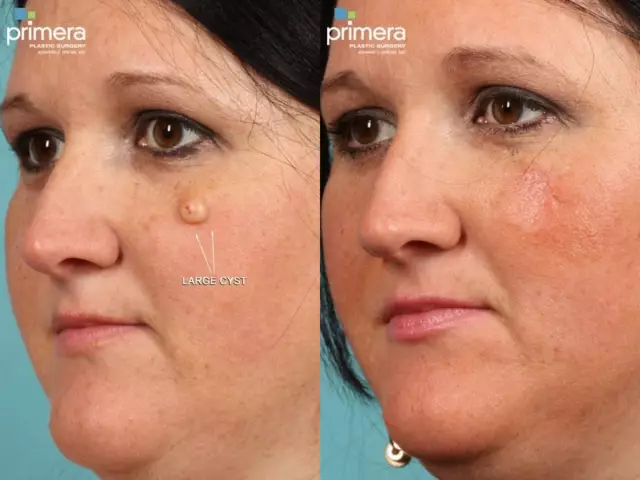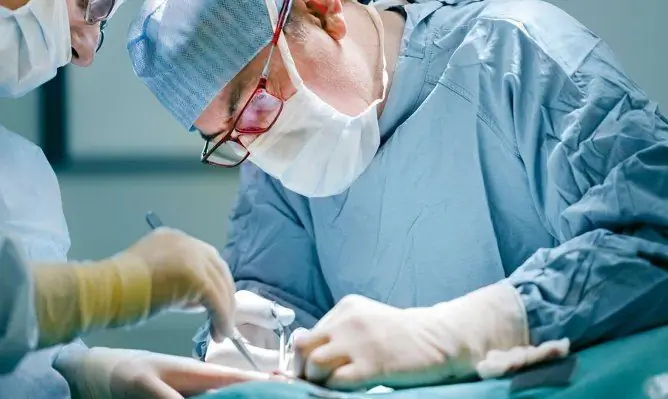- Author Rachel Wainwright [email protected].
- Public 2023-12-15 07:39.
- Last modified 2025-11-02 20:14.
Umbilical hernia
The content of the article:
- Causes and risk factors
- Forms of the disease
- Umbilical hernia symptoms
- Diagnostics
- Umbilical hernia treatment
- Possible complications and consequences
- Forecast
- Prevention
An umbilical hernia is a disease characterized by the protrusion of the abdominal organs beyond the anterior abdominal wall through the umbilical ring.

The main cause of an umbilical hernia is weakness of the transverse abdominal fascia
In most cases, an umbilical hernia occurs in children. The disease is diagnosed in about 20% of term infants and 30% of preterm infants. The incidence of umbilical hernia development is the same in male and female children; in adulthood, women are more susceptible to the disease.
After the baby is born, the umbilical cord is tied up and cut off. The umbilical cord is usually removed within 1-2 weeks. After the umbilical cord remains fall off, the umbilical ring closes and becomes overgrown with connective tissue. However, due to the weakness of the anterior abdominal wall and / or increased intra-abdominal pressure, internal organs may exit through the umbilical ring with the formation of an umbilical hernia.
Causes and risk factors
Most patients with umbilical hernia develop at an early age. The main cause is hereditary weakness of the transverse abdominal fascia. If one of the parents has an umbilical hernia in childhood, the probability of the disease in his child reaches 70%. Children who are below normal birth weight are more likely to develop the disease. Also, the occurrence of an umbilical hernia in childhood is facilitated by factors that cause an increase in intra-abdominal pressure. These include screaming, crying, frequent constipation, increased gas production in the intestines. The disease can appear against the background of prematurity, its development is facilitated by such pathological conditions as congenital hypothyroidism, lactose intolerance, intestinal dysbiosis, Down syndrome, Pfoundler's disease - Hurler, etc.
The development of an umbilical hernia in adults can be promoted by rapidly growing tumors, ascites, overweight, the presence of scars after surgery on the abdominal cavity, and abdominal trauma. The disease can appear due to excessive physical exertion, in which intra-abdominal pressure increases, which contributes to the release of internal organs into the hernial sac.

Excessive physical activity contributes to the appearance of an umbilical hernia
Intra-abdominal pressure can also increase due to some functional disorders of the gastrointestinal tract. Such pathologies include constipation, intestinal dysbiosis, lactose intolerance, etc. In addition, respiratory diseases, especially those accompanied by frequent unproductive coughs, can contribute to the occurrence of an umbilical hernia, since the diaphragm exerts pressure on the gastrointestinal tract.
A greater predisposition to the development of umbilical hernias in women is facilitated by the fact that the white line of the abdomen is wider in comparison with men. In addition, in women during pregnancy, the occurrence of an umbilical hernia may be associated with a weakening of the umbilical ring, atrophy of the tissues that surround it, as well as a sharp increase in intra-abdominal pressure during childbirth.
Forms of the disease
Umbilical hernias are:
- straight lines - occur with thinning of the transverse fascia, which is adjacent to the umbilical ring; the hernial sac exits through the umbilical ring into the subcutaneous tissue;
- oblique - a protrusion forms under or above the umbilical ring, passes through the gap between the white line of the abdomen and the umbilical canal and exits through the umbilical ring into the subcutaneous tissue.
Depending on the size of the hernial orifice and the volume of the contents of the hernial sac, umbilical hernias are divided into small, medium and large.
In addition, umbilical hernias can be reducible and irreducible.
Umbilical hernia symptoms
Umbilical hernias in children are usually not prone to infringement and in most cases do not cause much discomfort. There may be a small (up to 5 cm in diameter) bulge in the navel, which becomes more noticeable when straining, coughing, crying. At rest and in a horizontal position of the body, the hernia is almost or completely invisible. With larger hernias, children may experience colicky pain in the abdominal region, dyspeptic disorders.

Umbilical hernias in children are not prone to infringement
The clinical picture of an umbilical hernia in adults varies depending on the size of the hernia, the organs that enter the hernial sac, and the presence of concomitant pathologies. The main symptom of an umbilical hernia is a spherical bulge in the navel, which decreases or disappears in the horizontal position of the body. The pathological process may be accompanied by nausea, pain during physical exertion, coughing, sneezing. Sometimes patients complain of discomfort in the abdominal region, belching, flatulence, frequent constipation. Small hernias usually do not cause significant inconvenience to the patient and are not prone to infringement.

When the umbilical hernia is infringed, there is a sharp pain, intestinal obstruction, nausea and vomiting
Infringement of a hernia is accompanied by sudden severe pain, nausea, vomiting, intestinal obstruction, and it is impossible to reposition the hernia in a horizontal position.
Diagnostics
The diagnosis is usually not a problem. Diagnosis of the disease is based on data obtained as a result of collecting complaints and anamnesis, objective examination of the patient and instrumental diagnostics. To clarify the diagnosis, they resort to X-ray examination of the abdominal organs, fibrogastroduodenoscopy, ultrasound of the abdominal cavity. Instrumental diagnostic methods allow you to obtain the necessary information about the internal organs that are included in the hernial sac, the severity of the adhesive process, and intestinal patency.

Ultrasound of the abdominal cavity with an umbilical hernia allows you to assess the condition of the internal organs
Differential diagnosis is carried out with a hernia of the white line of the abdomen, metastases of stomach cancer in the navel, extragenital endometriosis with a lesion of the navel.
Umbilical hernia treatment
The choice of tactics for treating an umbilical hernia depends on the form of the disease, the presence of complications, contraindications and the general condition of the patient.
In children under 7 years of age, umbilical ring defects, as a rule, disappear, therefore, in patients of this age category, treatment of an uncomplicated umbilical hernia is not required, expectant tactics is justified.
Attention! Photo of shocking content.
Click on the link to view.
The main type of treatment for umbilical hernia in adult patients and in children over 7 years of age is surgery. Conservative therapy for an umbilical hernia, as a rule, is used in the case of an uncomplicated reducible hernia in the presence of contraindications to surgical treatment, including when a disease occurs during pregnancy. Also contraindications to surgical treatment can be acute diseases or exacerbations of chronic diseases, heart and / or pulmonary failure, immunodeficiency states, the active phase of the menstrual cycle in women. Such patients are shown wearing a bandage, strengthening the abdominal muscles, limiting physical activity.
The purpose of the surgical treatment (hernioplasty) is to reposition the internal organs into the abdominal cavity, remove the hernial sac, and strengthen the weak areas of the abdominal wall. Surgical intervention can be performed laparoscopic or open access. To remove an umbilical hernia, the traditional (tension) technique is used, in which the plastic of the umbilical hernia is carried out using local tissues, or tension-free, during which implants are used.
In the course of tension hernioplasty, the elimination of the hernial defect is carried out by tightening and stitching the muscles and aponeurosis. Tension hernia repair is usually recommended for small hernias and when the patient is not overweight. The methods of tension hernioplasty include the Mayo method, the Sapezhko method, and the Lexer method. The operation is carried out in several stages: dissection of superficial tissues, excision of the hernial sac, stitching of the tissues of the abdominal wall, suturing of the integument of the umbilical region. The likelihood of a relapse with this method is 2-14%. After the operation, it is necessary to exclude physical activity for three months.
During tension-free hernioplasty, synthetic implants are used. This method has a number of advantages, including the absence of tension in the patient's own tissues and the need to suture dissimilar tissues (the tension of dissimilar tissues, which occurs during traditional hernioplasty, causes a relapse). When carrying out tension-free hernioplasty, the hernia gate is closed with a mesh made of hypoallergenic material that does not cause allergic reactions and rejection. Some time after the operation, the mesh implant grows with the patient's own tissues. The implant is placed using one of two main methods. The first method is to place the implant over the aponeurosis directly under the skin. The method is usually used in elderly patients in the absence of the need for a quick return to an active lifestyle, since it has a relatively long rehabilitation period. Otherwise, the implant is located under the umbilical ring. This method is preferred in most cases and requires a shorter rehabilitation period.
Attention! Photo of shocking content.
Click on the link to view.
Surgical interventions by laparoscopic access are carried out through a small puncture under the control of a special video camera. The rehabilitation period after such operations usually does not exceed two weeks. Relapses occur in about 2-5% of cases. The advantages of surgery for an umbilical hernia by laparoscopic access include minimal tissue trauma, minimal discomfort, good cosmetic effect, a short rehabilitation period, and a small percentage of disease relapses.
The duration of the rehabilitation period after surgical treatment of an umbilical hernia depends on the method of surgery and the individual characteristics of the patient. After surgery, to maintain a weakened anterior abdominal wall, patients are shown wearing a bandage. In some cases, the bandage can be replaced with a wide belt. To prevent suture divergence in the first few days after the operation, the patient is shown bed rest. Antibiotics, analgesics, and physical therapy may be prescribed. In the rehabilitation period, a diet is necessary - spicy foods are excluded from the diet, as well as foods that can contribute to constipation and increased gas formation.
After the operation, dispensary observation is shown for several years.
Possible complications and consequences
An umbilical hernia can be complicated by intestinal obstruction, inflammation of the contents of the hernial sac, rupture of the hernia, infringement of the contents of the hernial sac, which, in turn, can cause the development of gangrene and death.
Forecast
With timely diagnosis and adequate treatment, the prognosis is favorable. In the absence of the necessary treatment, the prognosis worsens, the risk of developing complications of an umbilical hernia increases.
Prevention
There is no specific prophylaxis for an umbilical hernia.
In order to prevent the development of umbilical hernia in women during pregnancy, it is recommended:
- timely elimination of pathologies that contribute to the development of an umbilical hernia;
- wearing a bandage during pregnancy;
- preventing excess weight gain;
- strengthening the abdominal muscles;
- balanced diet.
In order to prevent the development of complications of the existing umbilical hernia and recurrence of the disease after the treatment, patients are recommended to undergo massage and physiotherapy courses aimed at strengthening the muscles of the anterior abdominal wall, as well as to avoid excessive physical exertion, in which there is an increase in intra-abdominal pressure.
YouTube video related to the article:

Anna Aksenova Medical journalist About the author
Education: 2004-2007 "First Kiev Medical College" specialty "Laboratory Diagnostics".
The information is generalized and provided for informational purposes only. At the first sign of illness, see your doctor. Self-medication is hazardous to health!






